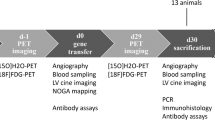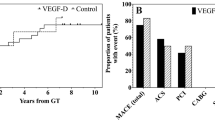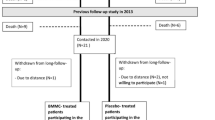Abstract
The purpose of this phase I clinical trial was to evaluate the safety, tolerability and potential efficacy of VM202, naked DNA expressing two isoforms of hepatocyte growth factor, as an adjunct therapy to coronary artery bypass grafting (CABG) in patients with ischemic heart disease (IHD). Nine patients were assigned to receive increasing doses (0.5 to 2.0 mg) of VM202 injected into the right coronary artery (RCA) territory following completion of CABG for the left coronary artery territory. Patients were evaluated for safety and tolerability, and changes in myocardial functions were monitored via echocardiography, cardiac magnetic resonance imaging and myocardial single photon emission computed tomography throughout 6-month follow-up period. No serious complication related to VM202 was observed throughout the 6-month follow-up period. Global myocardial functions (wall motion score index, P=0.0084; stress perfusion, P=0.0002) improved during the follow-up period. In the RCA region, there was an increase in the stress perfusion (baseline vs 3-month, P=0.024; baseline vs 6-month, P=0.024) and also in the wall thickness of the diastolic and systolic phases. Intramyocardial injection of VM202 can be safely used in IHD patients with the tolerable dose of 2.0 mg. In addition, VM202 might appear to have improved regional myocardial perfusion and wall thickness in the injected region.
This is a preview of subscription content, access via your institution
Access options
Subscribe to this journal
Receive 12 print issues and online access
$259.00 per year
only $21.58 per issue
Buy this article
- Purchase on Springer Link
- Instant access to full article PDF
Prices may be subject to local taxes which are calculated during checkout


Similar content being viewed by others
References
Mukherjee D, Bhatt DL, Roe MT, Patel V, Ellis SG . Direct myocardial revascularization and angiogenesis—how many patients might be eligible? Am J Cardiol 1999; 84: 598–600; A8.
Scott R, Blackstone EH, McCarthy PM, Lytle BW, Loop FD, White JA et al. Isolated bypass grafting of the left internal thoracic artery to the left anterior descending coronary artery: late consequences of incomplete revascularization. J Thorac Cardiovasc Surg 2000; 120: 173–184.
Caputo M, Reeves BC, Rajkaruna C, Awair H, Angelini GD . Incomplete revascularization during OPCAB surgery is associated with reduced mid-term event-free survival. Ann Thorac Surg 2005; 80: 2141–2147.
Naldini L, Vigna E, Narsimhan RP, Gaudino G, Zarnegar R, Michalopoulos GK et al. Hepatocyte growth factor (HGF) stimulates the tyrosine kinase activity of the receptor encoded by the proto-oncogene c-MET. Oncogene 1991; 6: 501–504.
Bottaro DP, Rubin JS, Faletto DL, Chan AM, Kmiecik TE, Vande Woude GF et al. Identification of the hepatocyte growth factor receptor as the c-met proto-oncogene product. Science 1991; 251: 802–804.
Morishita R, Aoki M, Hashiya N, Yamasaki K, Kurinami H, Shimizu S et al. Therapeutic angiogenesis using hepatocyte growth factor (HGF). Curr Gene Ther 2004; 4: 199–206.
Jayasankar V, Woo YJ, Bish LT, Pirolli TJ, Chatterjee S, Berry MF et al. Gene transfer of hepatocyte growth factor attenuates postinfarction heart failure. Circulation 2003; 108 (Suppl 1): II230–II236.
Funatsu T, Sawa Y, Ohtake S, Takahashi T, Matsumiya G, Matsuura N et al. Therapeutic angiogenesis in the ischemic canine heart induced by myocardial injection of naked complementary DNA plasmid encoding hepatocyte growth factor. J Thorac Cardiovasc Surg 2002; 124: 1099–1105.
Ahmet I, Sawa Y, Yamaguchi T, Matsuda H . Gene transfer of hepatocyte growth factor improves angiogenesis and function of chronic ischemic myocardium in canine heart. Ann Thorac Surg 2003; 75: 1283–1287.
Yasuda S, Goto Y, Baba T, Satoh T, Sumida H, Miyazaki S et al. Enhanced secretion of cardiac hepatocyte growth factor from an infarct region is associated with less severe ventricular enlargement and improved cardiac function. J Am Coll Cardiol 2000; 36: 115–121.
Ono K, Matsumori A, Shioi T, Furukawa Y, Sasayama S . Enhanced expression of hepatocyte growth factor/c-Met by myocardial ischemia and reperfusion in a rat model. Circulation 1997; 95: 2552–2558.
Jin H, Yang R, Li W, Ogasawara AK, Schwall R, Eberhard DA et al. Early treatment with hepatocyte growth factor improves cardiac function in experimental heart failure induced by myocardial infarction. J Pharmacol Exp Ther 2003; 304: 654–660.
Cho KR, Choi JS, Hahn W, Kim DS, Park JS, Lee DS et al. Therapeutic angiogenesis using naked DNA expressing two isoforms of the hepatocyte growth factor in a porcine acute myocardial infarction model. Eur J Cardiothorac Surg 2008; 34: 857–863.
Henry TD, Hirsch AT, Goldman J, Wang YL, Lips DL, McMillan WD et al. Safety of a non-viral plasmid-encoding dual isoforms of hepatocyte growth factor in critical limb ischemia patients: a phase I study. Gene Therapy 2011; 18: 788–794.
Gu Y, Zhang J, Guo L, Cui S, Li X, Ding D et al. A phase I clinical study of naked DNA expressing two isoforms of hepatocyte growth factor to treat patients with critical limb ischemia. J Gene Med 2011; 13: 602–610.
Morishita R, Aoki M, Hashiya N, Makino H, Yamasaki K, Azuma J et al. Safety evaluation of clinical gene therapy using hepatocyte growth factor to treat peripheral arterial disease. Hypertension 2004; 44: 203–209.
Powell RJ, Simons M, Mendelsohn FO, Daniel G, Henry TD, Koga M et al. Results of a double-blind, placebo-controlled study to assess the safety of intramuscular injection of hepatocyte growth factor plasmid to improve limb perfusion in patients with critical limb ischemia. Circulation 2008; 118: 58–65.
Carlsson M, Osman NF, Ursell PC, Martin AJ, Saeed M . Quantitative MR measurements of regional and global left ventricular function and strain after intramyocardial transfer of VM202 into infarcted swine myocardium. American journal of physiology. Heart Circ Physiol 2008; 295: H522–H532.
Saeed M, Saloner D, Do L, Wilson M, Martin A . Cardiovascular magnetic resonance imaging in delivering and evaluating the efficacy of hepatocyte growth factor gene in chronic infarct scar. Cardiovasc Revasc Med 2011; 12: 111–122.
Perin EC, Silva GV, Vela DC, Zheng Y, Baimbridge F, Gahremanpour A et al. Human hepatocyte growth factor (VM202) gene therapy via transendocardial injection in a pig model of chronic myocardial ischemia. J Card Fail 2011; 17: 601–611.
Nakamura T, Mizuno S . The discovery of hepatocyte growth factor (HGF) and its significance for cell biology, life sciences and clinical medicine. ProcJapan Acad 2010; 86 (6): 588–610.
Burr AW, Toole K, Chapman C, Hines JE, Burt AD . Anti-hepatocyte growth factor antibody inhibits hepatocyte proliferation during liver regeneration. J Pathol 1998; 185: 298–302.
Heeschen C, Dimmeler S, Hamm CW, Boersma E, Zeiher AM . Simoons ML. Prognostic significance of angiogenic growth factor serum levels in patients with acute coronary syndromes. Circulation 2003; 107: 524–530.
Pyun WB, Hahn W, Kim DS, Yoo WS, Lee SD, Won JH et al. Naked DNA expressing two isoforms of hepatocyte growth factor induces collateral artery augmentation in a rabbit model of limb ischemia. Gene Therapy 2010; 17: 1442–1452.
Hahn W, Pyun WB, Kim DS, Yoo WS, Lee SD, Won JH et al. Enhanced cardioprotective effects by coexpression of two isoforms of hepatocyte growth factor from naked plasmid DNA in a rat ischemic heart disease model. J Gene Med 2011; 13: 549–555.
Lee Y, Park EJ, Yu SS, Kim DK, Kim S . Improved expression of vascular endothelial growth factor by naked DNA in mouse skeletal muscles: implication for gene therapy of ischemic diseases. Biochem Biophys Res Commun 2000; 272: 230–235.
Kim KB, Cho KR, Chang WI, Lim C, Ham BM, Kim YL . Bilateral skeletonized internal thoracic artery graftings in off-pump coronary artery bypass: early result of Y versus in situ grafts. Ann Thorac Surg 2002; 74: S1371–S1376.
Acknowledgements
This study was supported by grants from ViroMed Co., Ltd (06-2006-273-0) and Reyon Pharmaceuticals Co., Ltd, Seoul, Korea.
Author information
Authors and Affiliations
Corresponding author
Ethics declarations
Competing interests
The authors declare no conflict of interest.
Rights and permissions
About this article
Cite this article
Kim, J., Hwang, H., Cho, K. et al. Intramyocardial transfer of hepatocyte growth factor as an adjunct to CABG: phase I clinical study. Gene Ther 20, 717–722 (2013). https://doi.org/10.1038/gt.2012.87
Received:
Revised:
Accepted:
Published:
Issue Date:
DOI: https://doi.org/10.1038/gt.2012.87
Keywords
This article is cited by
-
Stem cell therapy combined with controlled release of growth factors for the treatment of sphincter dysfunction
Cell & Bioscience (2023)
-
Progress in Clinical Gene Therapy for Cardiac Disorders
Molecular Diagnosis & Therapy (2023)
-
Safety and efficacy of plasmid DNA expressing two isoforms of hepatocyte growth factor in patients with critical limb ischemia
Gene Therapy (2016)



